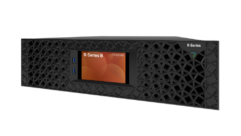
Coming Home to Windows Home Server Part 34
Dec 6, 2010 11:06 AM,
By Eric B. Rux
A Disturbance in the Force
“I felt a great disturbance in the Force, as if millions of voices suddenly cried out in terror and were suddenly silenced. I fear something terrible has happened.”
No, the planet Alderaan has not been destroyed by the Death Star; Microsoft has decided to remove Drive Extender (DE) from the next version of Windows Home Server (codenamed “Vail”).
What is Drive Extender, and why should you care? Drive Extender does a couple of neat things for the home user. First, it allows you to easily add drives to your “drive pool,” thereby increasing the amount of space available to store pictures, movies, etc. Second, Drive Extender can provide redundancy, where a file is stored on two physical hard drives.
There is simply no other feature like Drive Extender available—and it showed true innovation when Microsoft created it for WHS v1. Without it, Windows Home Server cannot easily grow with your music, TV, and movie collection. If a hard drives fails, you will have to rely on the OEM hardware vendor and/or third-party software products to protect your data.
Did Microsoft make this decision off the cuff? Of course not. A lot of thought and analysis went into the decision. Drive Extender (in its current form) is causing problems for the other business-oriented versions of Windows Server, which WHS is derived from. I’ll leave the technical details out, but let’s just say that Drive Extender is not compatible with some business software. So, Microsoft decided to remove it from all versions of Windows Server.
The reaction in the Windows Home Server community has been overwhelming, to say the least. Letters to Steve Ballmer have been written, customers have commented on Microsoft Connect, and online polls are showing WHS enthusiasts’ frustration with the decision.
What does all of this mean? Is Windows Home Server dead on arrival? This exact topic has been hotly debated the past two weeks. One conclusion is that Microsoft signed WHS’s death certificate with the removal of DE. Some have even renamed Windows Home Server Vail, to Windows Home Server Fail. Ouch.
The other camp is arguing that if DE really had the problems that Microsoft claims, then good riddance. Besides, Windows Home Server still has other great features such as client computer backup, media streaming, etc.
What do I think? I really hoped that Microsoft would reconsider, given the enormously negative feedback that it has received. Unfortunately, my sources tell me DE is dead. Move along; nothing to see here.
In the end, I think that Windows Home Server Vail will weather the storm. Either Microsoft will step up and come up with a decent DE alternative, or a third-party hardware or software vendor will fill the void that the removal of DE created. Or perhaps a combination of both.
Me? I’m going to keep writing about this amazing product. After all, we’ve only begun to scratch the surface of Vail in this column. I am excited about the possibilities for the next version of Windows Home Server, and I still have a lot more writing to do!
What do you think about Microsoft removing Drive Extender? Did they just kill WHS? Does this decision change your plans for Windows Home Server? I’d love to hear your feedback!
Eric B. Rux is a contributing editor for Windows IT Pro, and he writes a monthly column for Residential AV Presents Connected Home. Rux is the manager of Technical Support Services for Eastern Washington University and teaches the Microsoft Certified IT Professional (MCITP) certification program at a technical college.










